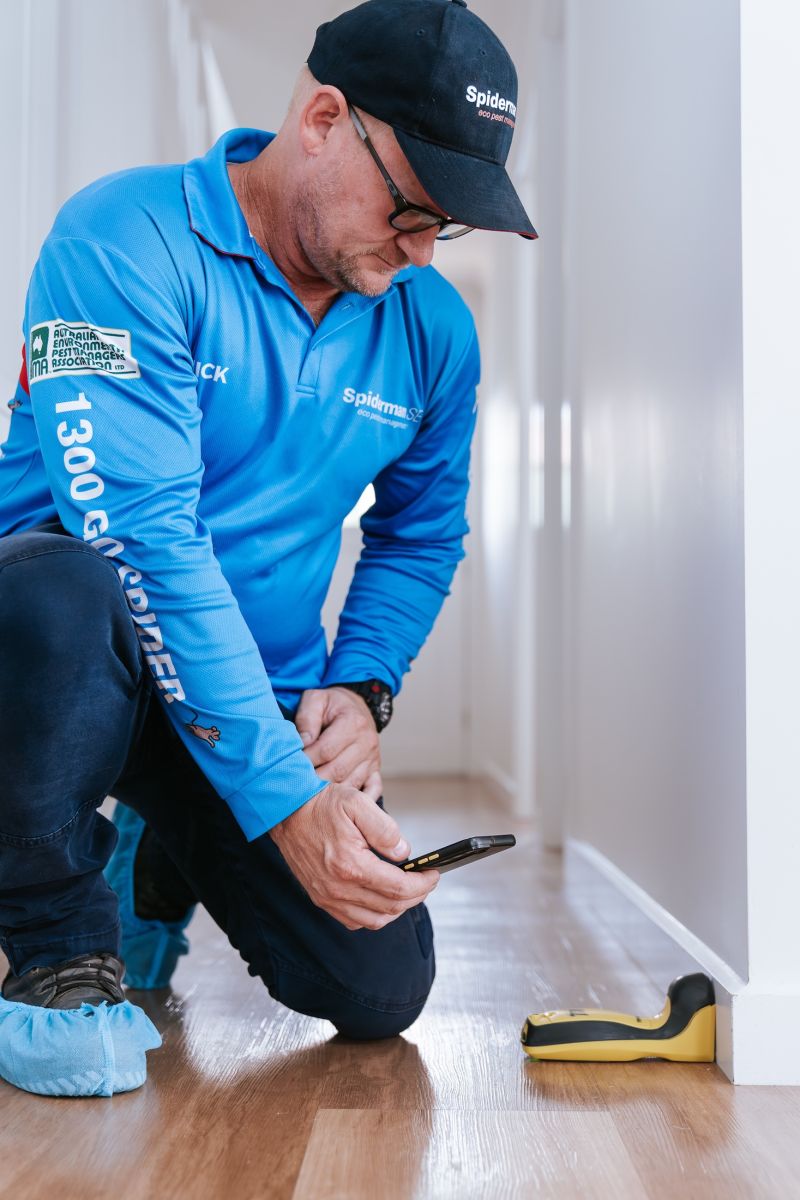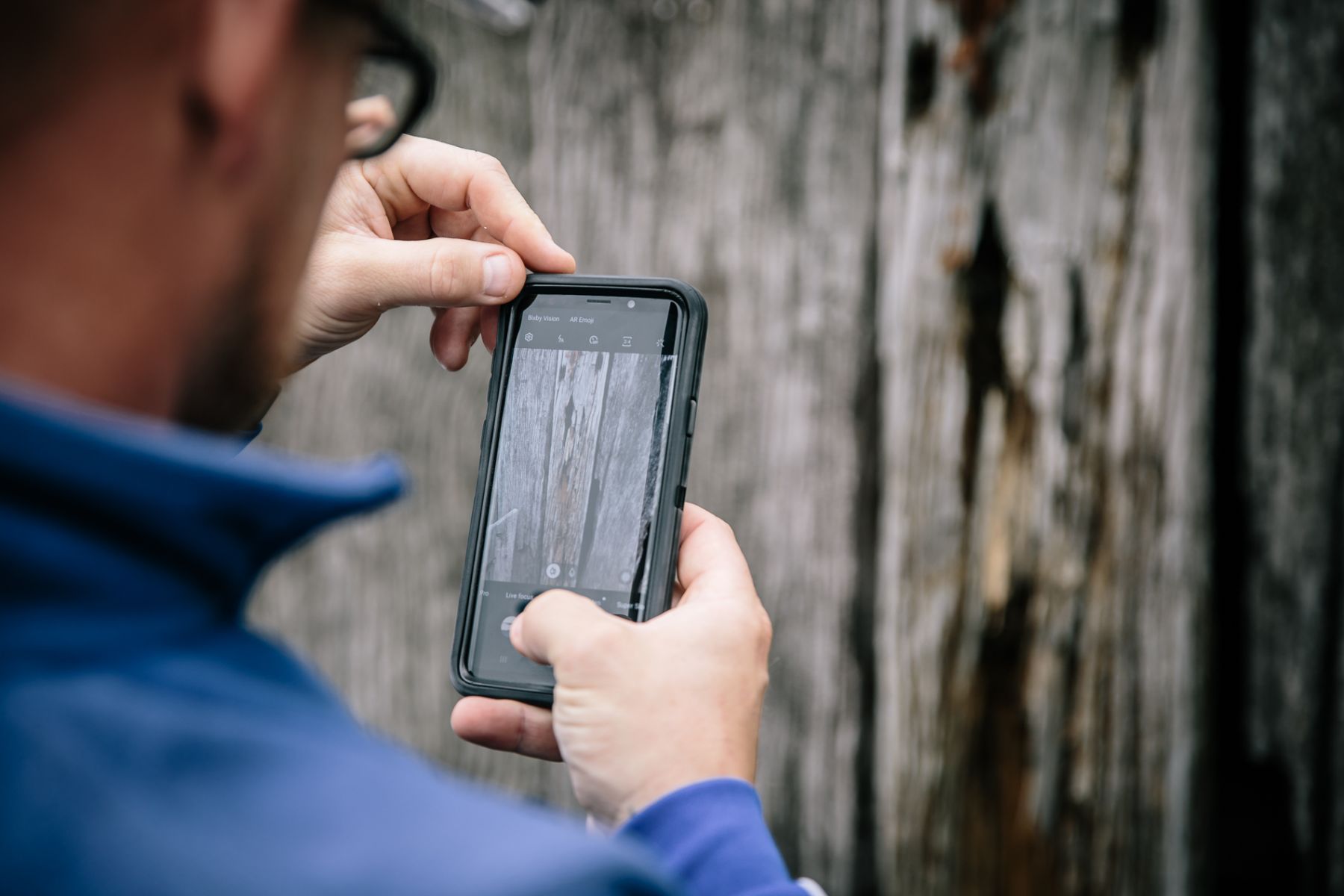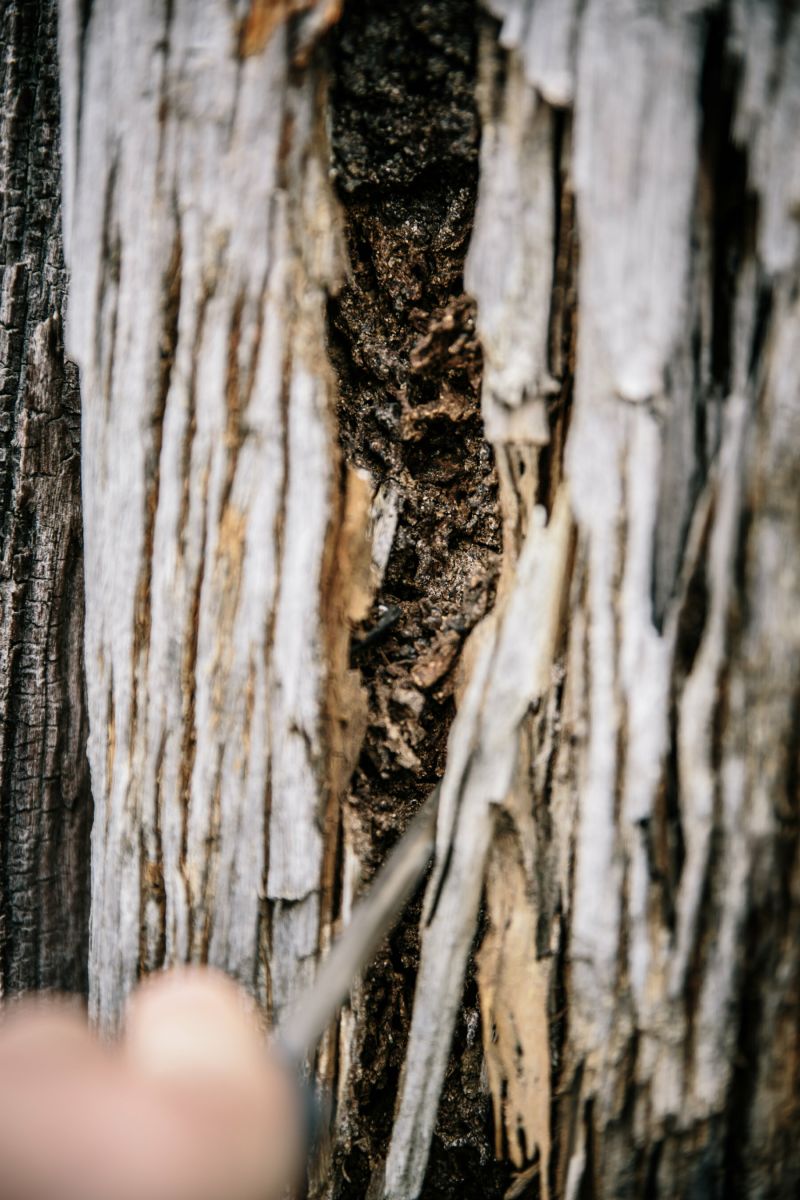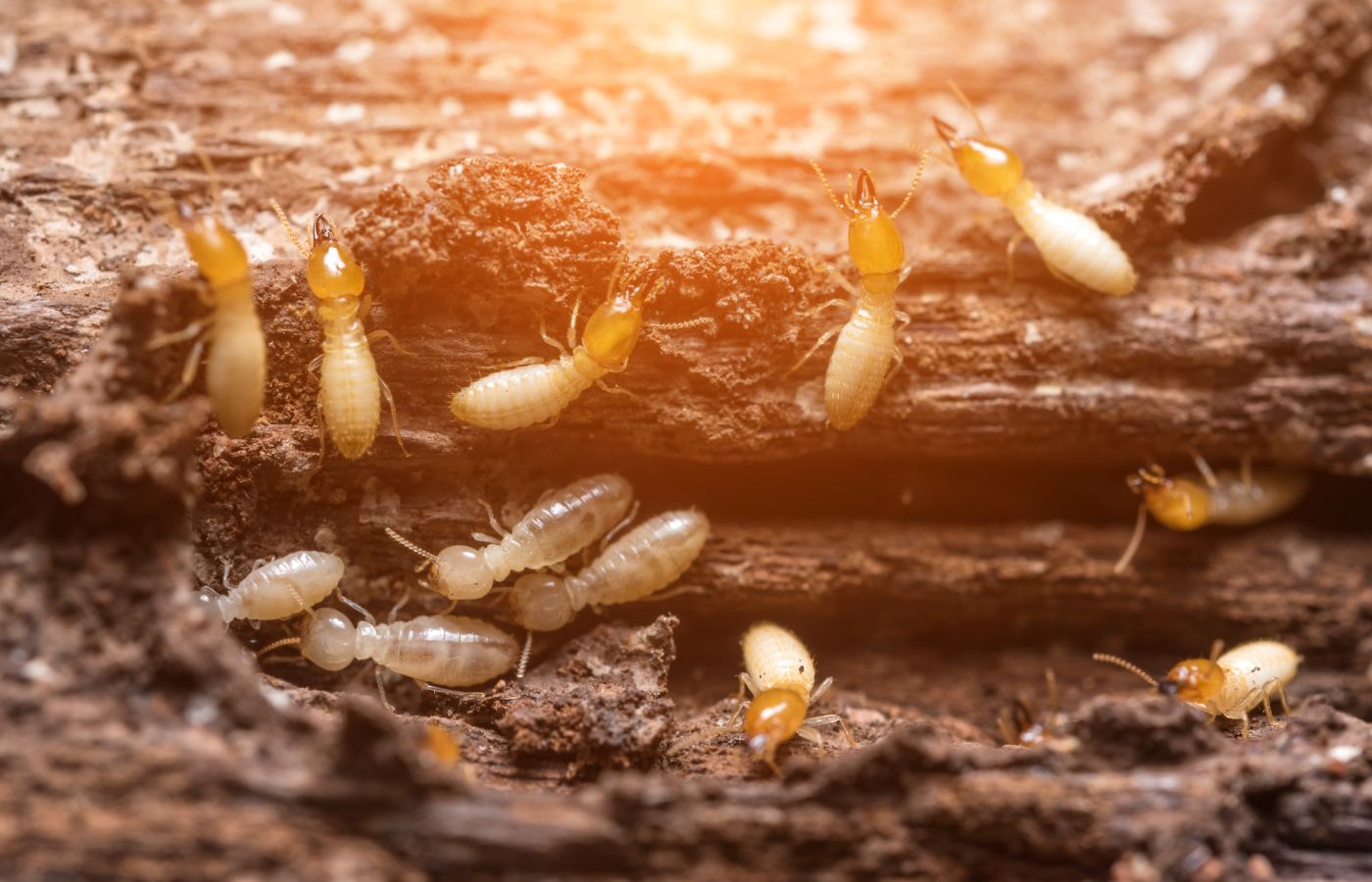
Our Termite Treatment Process
All our termite treatments are carried out according to Australian Standards 3660.2-2017 and follow the AEPMA Termite Treatment Industry Code of Practice.
The treatment follows 4 key steps:
- Carry out a comprehensive termite inspection
- Propose and agree to a termite treatment plan based on the inspection results
- Eliminate active termites from the building
- Install a termite management system to protect the home into the future
Following this robust process ensures the successful elimination of termite problems as quickly as possible, giving our customers the peace of mind that their homes are safe and protected from termites.
Comprehensive Termite Treatments for Mount Gambier and Surrounds
Call now to arrange an inspection and quote
The Process
- Determine the areas and scale of the termite activity/damage
- Pinpoint all the termite entry points
- Try and locate the termite nest(s) attacking your home (not always possible)
- Determine which termite species is causing the problem
- Identify construction faults that may have allowed the termites to enter
- List any environmental conditions that may have contributed to the termite attack
This information is vital so we can determine the correct treatment process and select the most appropriate products. It allows us to eliminate the termites as quickly as possible and protect your home.
It will contain all the information required for you to make a decision on your preferred treatment.
- The termite treatment proposal we present will be based on
- The nature of the termite infestation
- The construction of the building
- Any environmental factors at play
- Your preferences
- Budget considerations
We will tend to have a preferred option for your situation, but sometimes there may be more than one option. We can start the treatment once the termite treatment plan has been agreed upon.
- Find and destroy any termite nests on the property
- Eliminate active termites from inside the building
Although every effort is made to find and destroy termite nests on your property, they are often very hard to locate (as they are typically underground or in trees). Even if nests are located and destroyed, there is no guarantee that those are the nests that are attacking your home. As such, the termites inside the building have to be treated directly.
Eliminating termites from inside the property normally takes between 2 weeks and 3 months, depending on the products used and the nature of the infestation.
Once the termites have been eliminated, we can install a termite management system to provide long-term protection for your property.
There are two types of termite management systems.
- Liquid termiticide treatments to the soil
- Termite monitoring and baiting systems


Termite Product Information
Spiderman SE is accredited to apply a wide range of high-quality, specialist termite products to deal with termite infestations. The choice of product will very much depend on the situation we find on your property.
Treating Active Termites
When we treat active termites in your home, we may use one of two products
- Termite foam
- Termite bait
Foams kill the termites that come into contact with them and can be transferred to other termites, magnifying their effect. As long as enough termites come into contact with the treatment, foam treatments can be very successful and very quick.
However, in other situations, termite bait will be the better option. A termite bait is an attractive termite food containing a slow-acting insecticide. Termites feed on the bait, returning it to the nest, where it is fed to the queen and other termites. In addition to eliminating active termites from the building, it will also kill the colony. However, it will take longer to work (typically 1-3 months).
Protecting Your Home From Termites
Termiticide Soil Treatments
Liquid termiticides are applied to the soil around your property, creating a treated zone. Termites are either repelled by the chemical or killed when they try to enter the treated soil.
Our preferred product for soil treatments is Termidor. As accredited Termidor installers, we can offer a $2 million treatment assurance warranty on qualifying treatments.
Although liquid soil treatments are a popular termite management system, termite monitoring and baiting systems are better for specific construction types, rocky soils, or sloping blocks.
Termite Monitoring and Baiting Systems
Termite monitoring and baiting systems consist of plastic housing installed in the ground around your home. Traditional monitoring systems contain samples of wood. If termites are active in the area, they will start feeding on this wood. This activity is picked up in the regular inspections (every 6-12 weeks), and then a termite bait is added, which the termites feed on, ultimately killing the colony.
Spiderman SE uses Sentricon AlwaysActive which is the latest in termite baiting systems. It is different from traditional termite monitoring and baiting systems in that it does not use wood and then replace it with bait – it simply contains termite bait from the point of installation, meaning it is always active, protecting your home. In addition, inspection of the stations is only required every 3-6 months, meaning fewer visits from us and less cost to our customers.
Termite FAQs
Finding termites can be a shock and quite upsetting. We have all heard horror stories of homes so damaged that they are structurally unstable and families devastated by colossal repair bills.
Prevention is the best cure, but if you have already found termites on your property, read through the following important information before you do anything.
Termite infestations are usually discovered by accident. Termites travel in "mud tubes" and keep themselves concealed between walls, roof and subfloor voids and occasionally in furniture. Signs of termites may include mud tubes, discoloured, flaking or bubbling paint, soft spots in the wall or door/window frames, swollen timbers, electrical connection problems and sometimes small piles of dirt, often hidden in the corners of cupboards.
Termites are often (incorrectly) called "white ants" because of their appearance. If you have found an area with the above signs and the presence of small white-looking 'ants', unfortunately, you may have found termites on your property.
The most important thing you can do is NOT disturb them any further.
You may be tempted to spray them with insect or surface spray and clean up the dirt and damage. Don't! We aim to eradicate termites from your home, and the best results are achieved by treating them by applying special products directly to the live termites and their workings. Disturbing them may cause them to retreat and block off the area from their tunnel network that leads back to the nest, making treatment much more difficult and much less successful.
Secondly, don't panic! If you have found termites, they have likely been there for some time and will not cause significant amounts of damage in a few days. Your first step is to have the property inspected by a qualified technician who is experienced in termite work. At Spiderman SE, our technicians are skilled, and accredited, and have extensive experience in all types of termite applications.
Again, don't panic.
Don't disturb them any further and arrange an inspection as soon as possible. There are still treatment options available if you have disturbed the termites, and we will be able to provide information on the suitable treatment options.
Finding termites is a good thing, as you can now take steps to eradicate them. Imagine the damage they could continue to cause if you had not found them.
No. Spraying surfaces for termites does not work. Spraying termites directly with pesticides will kill the ones you hit but will not kill the colony from which they came.
Effective termite treatment consists of 4 key steps:
- Carry out a comprehensive termite inspection.
- Propose and agree to a termite treatment plan based on the inspection results.
- Eliminate active termites from the building.
- Install a termite management system to protect the home into the future.
No.
Under-slab sprays were once a common solution for termite protection, involving the application of chemicals under the slab during construction. However, these chemicals break down over time, and once they do, they can’t be replenished. That means your termite barrier loses its effectiveness, leaving the building vulnerable to termite attack down the track.
The Building Code of Australia (BCA) now requires that chemical systems in concealed or hard-to-access areas must be replenishable, as per the 2014 revision of AS 3660.1. Under-slab sprays, by their nature, don’t allow for this replenishment without significant disruption to the structure.
Please visit our blog for more information.
Information for Builders is available on the HIA website here.
Because there is no room for shortcuts when it comes to termite management.
All our termite treatments are carried out according to Australian Standards 3660.2-2017 and follow the AEPMA Termite Treatment Industry Code of Practice.
The treatment follows 4 key steps:
- Carry out a comprehensive termite inspection.
- Propose and agree to a termite treatment plan based on the inspection results.
- Eliminate active termites from the building.
- Install a termite management system to protect the home into the future.
Following this robust process ensures the successful elimination of termite problems as quickly as possible, giving our customers the peace of mind that their homes are safe and protected from termites.
When people ask how much a termite treatment costs, it is like asking, "How long is a piece of string"? Many variables are involved, and a professional quote can only be provided after an on-site inspection. You should be concerned about any company prepared to give a quote over the phone.
A termite treatment typically consists of two stages:
- Eliminate active termites from the building.
- Install a termite management system to protect the home into the future.
The price of Stage 1 will depend on the product used, the size of the infestation and the species present. But it is Stage 2 of the treatment which is the biggest cost component of a termite job. Here are some factors that come into play:
- Size of the house – the larger the house, the higher the cost (more area to treat).
- Construction type – Is the home on a concrete slab or does it have a sub-floor? Homes with a sub-floor have a larger area to treat.
What type of soil is around the home? (Poor-quality / rocky soils may need to be replaced before applying the soil termiticide.) - Does the area surrounding the house consist of soil, pavers or concrete? Soil has to be dug up, pavers have to be lifted and replaced, concrete has to be drilled and injected.
- What type of soil is around the home? If the soil is of poor quality and has a large number of stones, it may need to be replaced by quality loam soil before the treatment can be applied.
Our Standard Termite and Timber Pest Inspections start at $450.00.
We inspect the property for three types of timber pests – termites, borers and wood decay. The report will document:
- Any visual evidence of current timber pest activity (termite, borer, wood decay)
- The extent and location of any timber pest damage
- Any construction issues and environmental conditions that make the property more susceptible to future timber pest attack
- A summary of the risk of ongoing and future damage to the property
- Recommendations for solving construction and environmental issues to make the property less likely to suffer timber pest damage
- Report on any pre-existing termite management systems in place
- Recommendations for a termite management plan to eliminate any current infestation and aid in reducing any risk of future infestations
Termite inspections can vary significantly in cost, and it's essential to understand what you're paying for. At Spiderman SE Eco Pest Management, we pride ourselves on providing thorough, professional Standard Timber Pest Inspections, which go far beyond the basic visual termite inspections many other companies offer. Here's what sets us apart:
Our Comprehensive Inspection Process:
1. Detailed Room-by-Room Inspection: We meticulously inspect every room in your home, tapping walls and wooden elements and scanning wet areas for leaks.
2. Roof Void Examination: We enter the roof void and carefully check every timber to ensure no hidden termite threats.
3. Sub-Floor Inspection: For homes with sub-floors, we examine all the flooring timbers to identify any potential issues.
4. Exterior Building Inspection: We don't just stop at the interior; we also thoroughly inspect the exterior of your home.
5. Outbuilding and Property Assessment: Any outbuildings and the property up to 50 meters from the main building are also checked, including fences, trees, and other structures.
This comprehensive approach naturally takes time. A detailed inspection of a standard 3-4 bedroom home should take at least 2 hours. Add to this the travel time to and from your property and a couple of hours to write a thorough report, and you can see that a professional termite inspection is a significant undertaking—at least a 4-hour exercise.
Choosing a company that rushes through the job or offers a suspiciously low price may initially seem like a bargain. However, you could end up wasting your money and, worse, putting your home at risk. A quick, cheap inspection often misses crucial details that can lead to significant problems.
Our Pre-Purchase Termite and Timber Pest Inspections start at $550.00.
We inspect the property for three types of timber pests – termites, borers and wood decay. The report will document:
- Any visual evidence of current timber pest activity (termite, borer, wood decay)
- The extent and location of any timber pest damage
- Any construction issues and environmental conditions that make the property more susceptible to future timber pest attack
- A summary of the risk of ongoing and future damage to the property
- Recommendations for solving construction and environmental issues to make the property less likely to suffer timber pest damage
- Report on any pre-existing termite management systems in place
- Recommendations for a termite management plan to eliminate any current infestation and aid in reducing any risk of future infestations
Termite inspections can vary significantly in cost, and it's essential to understand what you're paying for. At Spiderman SE Eco Pest Management, we pride ourselves on providing thorough, professional Standard Timber Pest Inspections, which go far beyond the basic visual termite inspections many other companies offer. Here's what sets us apart:
Our Comprehensive Inspection Process:
1. Detailed Room-by-Room Inspection: We meticulously inspect every room in your home, tapping walls and wooden elements and scanning wet areas for leaks.
2. Roof Void Examination: We enter the roof void and carefully check every timber to ensure no hidden termite threats.
3. Sub-Floor Inspection: For homes with sub-floors, we examine all the flooring timbers to identify any potential issues.
4. Exterior Building Inspection: We don't just stop at the interior; we also thoroughly inspect the exterior of your home.
5. Outbuilding and Property Assessment: Any outbuildings and the property up to 50 meters from the main building are also checked, including fences, trees, and other structures.
This comprehensive approach naturally takes time. A detailed inspection of a standard 3-4 bedroom home should take at least 2 hours. Add to this the travel time to and from your property and a couple of hours to write a thorough report, and you can see that a professional termite inspection is a significant undertaking—at least a 4-hour exercise.
Choosing a company that rushes through the job or offers a suspiciously low price may initially seem like a bargain. However, you could end up wasting your money and, worse, putting your home at risk. A quick, cheap inspection often misses crucial details that can lead to significant problems.
Borer FAQs
Look for small, round exit holes in the timber, fine powdery dust (frass) near the holes, and wood that feels weakened or damaged. Other timber pests, like termites or wood decay fungi, can cause similar problems, so a full Termite and Timber Pest Inspection is the best way to confirm what’s going on.
Yes. Some borer species only spend a short time in timber, but others can remain for years, slowly weakening it. If left untreated, this can lead to structural issues in flooring, architraves, roof timbers and other key areas of your home.
In most cases, replacing the affected timber is the best fix. If the damage is localised (like a single floorboard or architrave), removing and replacing that section will eliminate the problem. Small items may sometimes be treated with freezing or localised heat.
No. Chemical treatments generally don’t penetrate deep enough to kill the larvae inside the wood. Insecticides may kill adult borers as they emerge, but they won’t stop the damage already happening inside.
No. Fumigation is rarely necessary for residential properties. Replacing affected timber is almost always the most effective and practical solution.
Borers are attracted to damp or untreated timber. Keeping your timber dry, well-ventilated and sealed will help. Avoid direct timber-to-soil contact and book regular pest inspections so any issues can be caught early.
Book a full Termite and Timber Pest Inspection with Spiderman SE. We’ll identify the problem and give you clear, practical advice on the best course of action.

